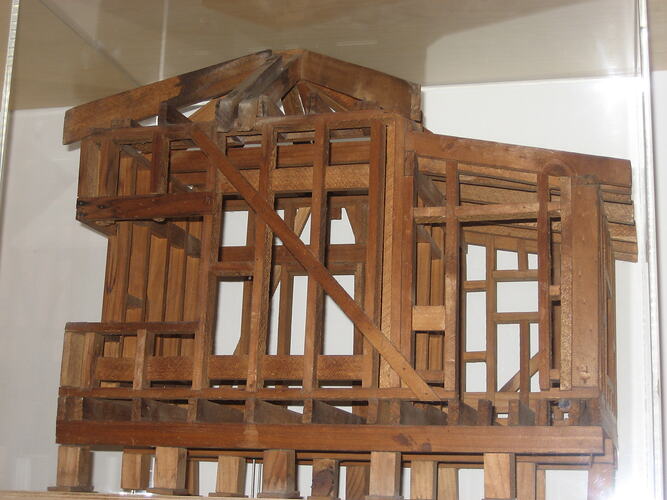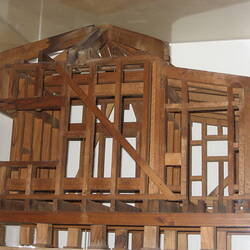Summary
Wooden house frame model, constructed by a mature age male student between 1960 and 1963, while attending night classes as part of a three-year carpentry course at Caulfield Technical College. Most of the other students were carpentry apprentices. The frame represents the structural framework required for the construction of a typical domestic dwelling. It represents part of a home, and includes stumps. Constructing such a model was a standard requirement of the course.
Skilled carpenters were urgently needed in a booming building industry, trying to keep up with post-war demand. Many men completed carpentry studies at night classes. The donor undertook the course with the idea of becoming a builder. On completion of the course he worked as a carpenter on a few local jobs constructing single houses for small contractors. He was unhappy working with 'foreigners' and felt that they exploited his knowledge and skills, and received the same wage without an equivalent qualification. The donor explains that this was why he didn't pursue work as a builder. The donor used his carpentry skills to build his own home in the mid-1960s at his weekend farm at Tynong, he also established his own carpentry repair business.
Physical Description
Model of domestic house frame, made with undressed timber. The frame represents the structural framework required for the construction of a typical domestic dwelling. It represents part of a home, and includes stumps.
Significance
In the 1950s and 1960s Melbourne's housing market was booming, this was fuelled by the increasing population and greater financial security and prosperity of the times.
This model represents the style of home built during the early 1960s. The unfinished, raw texture of this model is symbolic of the rash of new housing emerging across suburban Melbourne at this time. It also offers another layer of interpretation relating to the training needs and workforce required for the building industry in its efforts to keep up with the consumer demand. In addition to documenting this period of housing construction, the donor also offers some insights into his attitudes and experiences of working with migrants involved in the construction industry.
More Information
-
Collecting Areas
-
Acquisition Information
Donation from Reg Dale, 05 Sep 2006
-
Maker
Reg Dale, Caulfield, Greater Melbourne, Victoria, Australia, 1960-1963
-
Organisation Named
Caulfield Technical College, Caulfield, Greater Melbourne, Victoria, Australia, 1960-1963
-
Classification
Building & construction, Structures & framing, Model framing
-
Category
-
Discipline
-
Type of item
-
Approximate Dimensions
54 cm (Length), 33 cm (Width), 49 cm (Height)
-
Maximum dimensions
332 mm (Length), 535 mm (Width), 485 mm (Height)
Measurement From Conservation.
-
Keywords


